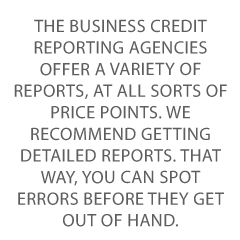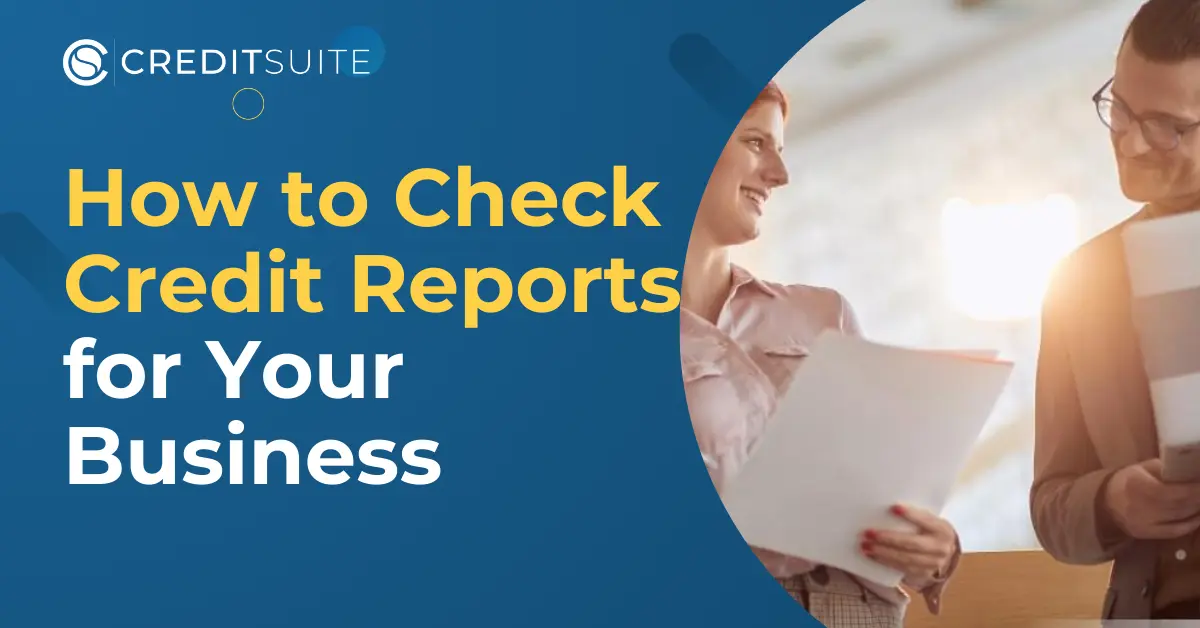Do You Know How to Check Credit Reports for Your Business?
If you’re a business owner, chances are it’s been on your to-do list for quite a while: check credit reports. But do you know how to do this fast?
Business owners are always short on time. Find out here how to check credit reports with efficiency.
This blog post may contain affiliate links, meaning when you click the links for some products and make a purchase, Credit Suite receives a commission at no additional cost to you.
You Need to Check Credit Reports as a Part of Building and Maintaining Business Credit
Business credit is credit which is in a business’s name. It is does not tie to owner creditworthiness. Instead, business credit scores depend on how well a company can pay its bills. Hence consumer and business credit scores can vary.
Credit Reporting Agencies
There are three large business CRAs:
- Dun & Bradstreet
- Experian and
- Equifax
There is also the FICO SBSS business score and CreditSafe. But today, we will focus on the big three’s reports.
Check Credit Reports for Your Business
The business credit reporting agencies offer a variety of reports, at all sorts of price points. We recommend getting detailed reports. That way, you can spot errors before they get out of hand.
If a report with details isn’t in the budget right now, at least a shorter summary report will keep you in the loop. And it will keep in the habit of checking your credit reports. It’s more than a credit score check. Today, we’ll look at high level data. This is what you absolutely must know.
Dun & Bradstreet
There are over millions of companies around the world in D&B’s database. You need a D-U-N-S number to start building business credit. No D-U-N-S number? Then get one; they’re free. The main score is PAYDEX. But a business will not get a PAYDEX score, unless it has at least 3 trade lines reporting, and a D-U-N-S number. A business must have BOTH to get a D&B score or report.
Predictive Models and Scoring
D&B takes historical information to try and predict future outcomes. This is to identify the risks inherent in a future decision. They take objective and statistically derived data, rather than subjective and intuitive judgments. There are sample reports online available on the D&B website.
D&B Rating
This rating helps companies quickly assess a business’s size and composite credit appraisal. Dun & Bradstreet bases this rating on information in a company’s interim or fiscal balance sheet plus an overall evaluation of the firm’s creditworthiness. The scale runs 5A—HH.
Rating Classifications show company size due to worth or equity. D&B assigns such a rating only if a company supplies a current financial statement.
The rating contains a Financial Strength Indicator. D&B calculates it using the Net Worth or Issued Capital of a company. Plus there’s a Composition Credit Appraisal. This number runs 1 through 4, and it reflects D&B’s overall rating of a business’s creditworthiness. The scores mean:
- 1 – High
- 2 – Good
- 3 – Fair
- 4 – Limited
A D&B rating might look like 3A4.
D&B PAYDEX
This part shows two gauges: an up to 24 month PAYDEX, and an up to 3 month PAYDEX. Hence you can see recent history and a firm’s performance over time.
Both gauges have the same scores:
- 1 means greater than 120 days slow (in paying bills)
- 50 means 30 days slow
- 80 means prompt
- 100 means anticipates
100 is the best PAYDEX score you can get. The PAYDEX score is Dun & Bradstreet’s dollar-weighted numerical rating of how a company has paid the bills over the past year. It reflects how well a company pays its bills.
Financial Stress Score
This section shows a Financial Stress Class, and a Financial Stress Score Percentile. The Financial Stress Class runs 1—5, with 5 being the worst score.
Financial Stress Score Percentile
This is compares to other businesses. The percentile contains a Financial Stress National Percentile. The Financial Stress National Percentile reflects the relative ranking of a company among all scorable companies in D&B’s file. It also contains a Financial Stress Score. The report indicates the probability of failure with a particular score.
Financial Stress Score Percentile Comparison
The idea behind this score is to predict the chance that a business will fail over the next 12 months. The average probability of failure compares to other businesses in D&B’s database. And the Financial Stress National Percentile reflects the relative ranking of a company among all scorable companies in D&B’s file.
The Financial Stress Score offers a more precise measure of the level of risk than the Financial Stress Class and Percentile. It is meant for customers using a scorecard approach to determining overall business performance.
PAYDEX Yearly Trend
The PAYDEX Yearly Trend is a graph. It includes payment history in detail, with payment habits and a payment summary. It helps show if a business pays its bigger bills first or last
D&B Business D&B Credit Insights
Gain a comprehensive understanding of your business Credit scores & ratings to effectively strategize for your business’s trajectory. D&B Credit Insights caters to the needs of small business owners seeking to intimately comprehend their business credit landscape. Receive instantaneous alerts regarding fluctuations in your business scores and ratings, empowering you to swiftly identify and address potential concerns.
As of March 2024, D&B Credit Insights offers a free and affordable basic plan.
Let’s take a look at Experian.
Experian
Experian has a massive consumer and commercial database that they use to gauge risk.
“By combining personal and commercial credit information in one report, Experian provides a complete picture of the creditworthiness of small businesses.”
Their best known and most popular score is Intelliscore Plus℠, a percentile score.
Experian’s Intelliscore Plus℠
Business credit scores range 0—100. An Intelliscore Plus score of 0 represents a high risk. It reflects the percentage of businesses scoring higher or lower than the business under review.
Many large financial institutions around the world use it. So do more than half of the top 25 P&C insurers and most major telecommunications and utility firms.
Industry leaders in transportation, manufacturing, and technology also use Intelliscore Plus as their main risk indicating model. It has more than 800 aggregates or factors affecting business credit scores. There are scores on millions of businesses in the Experian database.
What does Intelliscore Plus measure?
This is a highly predictive score. It provides a detailed and accurate reflection of a business’s risk. It blends commercial data and consumer data on the business owner or guarantor. Reports include information on trades, legal filings, and more.
The Experian Financial Stability Risk Score (FSR)
In an Experian business credit report, FSR predicts the potential of a business going bankrupt or defaulting on its obligations. The score identifies the highest risk businesses by making use of payment and public records which include:
- Severely delinquent payments of 61+ and 91+ days
- High utilization of credit lines
- Tax liens
- Judgments
- Collection accounts
- Industry risk
- Short time in business, etc.
FSR shows a 1—100 percentile score, plus a 1—5 risk class. The risk class puts businesses into risk categories. The highest risk is in the lowest 10% of accounts. A score of 66—100 and a risk class of 1 means a low risk of default or bankruptcy. But a score of 1—3 and a risk class of 5 means a high risk of default or bankruptcy.
Experian Business Credit Monitoring
Experian offers monitoring services.
- Business Credit Advantage: monitor business credit for 1 year, alerts of changes
- Business Credit Score Pro: multiple business credit report access.
- Profile Plus: a single report
- Credit Score Report: credit summary report with score.
Experian Subscription Plans: The Business Credit Advantage Subscription Plan
This is just one report including almost everything Experian offers. It includes:
- Business Credit Score (Intelliscore)
- Financial Stability Risk Rating
- Collections and trade payment details
Experian Subscription Plans: The Business Credit Score Pro Subscription Plan
Get 30 reports per month but it’s not a free credit score. It does not include:
- Alert Emails & Monitoring
- Dispute Resolution Status Alerts
- 3-Month Score Trend
- Unlimited Access to Your Report
- Business Identity Monitoring
Experian also offers an enhanced version of this plan. Get more information, including:
- Trade payment detail
- UCC detail
- Inquiry detail
But it is far from being a free credit report!
Experian Reports: The Profile Plus Report
Check credit reports with everything in the Business Credit Score Pro Subscription Plan, plus (optional with a more expensive report):
- Trade Payment Detail
- Inquiry Detail
- UCC Detail
- Corporate Financial Information
Experian Reports: The Credit Score Report
Get everything in the Business Credit Score Pro Subscription Plan, but no optional sections. The credit score report is like a one-time version of the Business Credit Score Pro Subscription Plan. You can use it to decide if you want to subscribe to the more expensive plan.
Let’s turn to Equifax.
Equifax and Its Data
The company gets its data from a data sharing agreement with the Small Business Exchange. It gets net 30 type industry trade credit information from a wide variety of suppliers that provide products and services to businesses on an invoice basis. Equifax combines financial data with industry trade credit data, and adds utility and telephone data.
It also adds public record information (bankruptcies, judgments, and tax liens).
Credit Risk Score
In an Equifax business credit report, the Credit Risk Score runs 101—992. Higher numbers are better. This section also shows key factors, which are positives and negatives about your business. Like how old your oldest account is, and if you have any charge-offs, and the size of your business.
Payment Index
This score runs 0—100. Higher numbers are better. It also shows Industry Median. 90+ means Paid as Agreed.
Business Failure Score
The next piece is on your Business Failure Score. This score runs 1000—1880. It has its own key factors, like recent balance information.
Equifax Business Credit Monitoring
Prices are current to September 2021. Check credit reports which include credit summary, payment trends, and public records. The idea is to help you identify potential risk of late payments and business failure. Order a single Business Credit Report or order a Business Credit Report multi-pack (5 for the price of 4).
Improving Your Business Credit Reports
Make sure vendors are reporting your payments. Always pay your bills on time. Pay them in full. Don’t close positive accounts. Try to avoid derogatories like liens.
Keep Track of Your Business Credit at Major CRAs for Less
All these reports are expensive! You could spend HUNDREDS of dollars trying to keep up with reports from the business CRAs.
But did you know that you can get business credit tracking for all three big business CRAs, and all in one place—for less? Credit Suite offers this through our Business Finance Suite. See what credit issuers and lenders see. So you can improve your scores and get the business credit and funding you need.
Check Credit Reports for Your Business: Takeaways
In general, the most important parts of any business credit report include:
- Scores or graphs denoting risks of failure or nonpayment
- Data on public records
- Information on how quickly (or slowly) you pay your company’s bills
Improving reports means paying on time more than anything else. Reports can be expensive—we can help you monitor for less.

